|

Sightseeing with a Licensed Guide
© Branko Rabotic
1998-2006
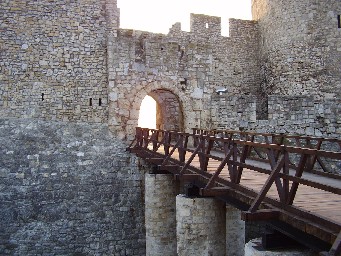
 Serbian
version
Serbian
version
Home/History
| Exhibition
| Photo Tour | Plan
Photo Tour of Belgrade Fortress
Artillery Fort & Medieval Acropolis
of Belgrade
|
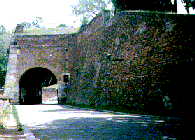 Big
Ravelin & Stambol Gate I (1740-1760) Big
Ravelin & Stambol Gate I (1740-1760)
This large artillery structure, triangular
in shape, was once an outwork of the fortress, built in accordance with
the principles of modern military architecture of the 18th century. It
has two embankments shaped like an arrowhead that point outwards. Two
outer sides are overlaid by bricks and its interior is filled with
earth. The two corner gates are still well preserved. One of them is
named after the city of Istanbul. |
|
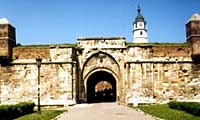 Fortification
front & Stambol Gate II (1740-1760) Fortification
front & Stambol Gate II (1740-1760)
The main front of fortification
consists of a curtain-wall and two bastions, one on its each end.
Both bastions still have apertures (embrasures) through which the main
entrance was once defended under cross-fire from the cannons. In
the middle of the fortification front lies the main gateway, known as
the Stambol gate II. Both doors are well preserved with traces of
an attack. In the vaulted passage there are flank guards. |
|
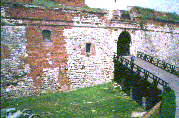 Southeast
rampart of the Acropolis (15th - 17th centuries) Southeast
rampart of the Acropolis (15th - 17th centuries)
The southeast rampart of the Upper town
lies at the southern border of the main 15th century fortification. The
stone wall we can see here is fundamentally of mediaeval origin, though
its present appearance dates back to the late 17th century. A new
curtain-wall was then built by the Venetian engineer Andrea Cornaro,
covering the foregoing and then badly damaged original rampart. |
|
 Clock
Gate & Clock Tower (17-18th centuries) Clock
Gate & Clock Tower (17-18th centuries)
The present-day gateway leading to the
area of the Acropolis was built by Andrea Cornaro in the late 17th
century. It is known as the Clock or Sahat gate though this
Turkish name (sahat = clock) has little to do with its actual
origin. The name was given later by way of associating the gate with the
Baroque clock tower, erected above it more than 50 years after
its construction. The Clock tower is open for visits in 2005 (there is a
small entrance fee). |
|
 Fortress
cannon Fortress
cannon
Close by the gate, from the other side,
one can see a weighty fortress cannon, one of the largest of its
kind, which dates back from the late-18th or early-19th century and
represents a fine example of defense artillery. It has been brought from
some other location and partially reconstructed along with its gun
carriage. |
|
 Turkish
Mausoleum (18th century) Turkish
Mausoleum (18th century)
This 'turbeh' was erected in
1784 to contain mortal remains of a Turkish vizier who died in Belgrade.
Surprisingly, in the first half of the 19th century the Turks renamed
the mausoleum after another personality, after their hero Damad Ali
Pasha, who was wounded in a battle with the Austrians at Petrovaradin in
1717 and died soon afterwards. Although his grave is not here, the
mausoleum still has the same name. This is one of the rare monuments of
the long lasting Ottoman occupation of Belgrade. |
|
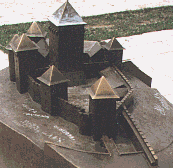 Model
of the Castle Model
of the Castle
On the plateau in the north-west
corner of the Upper town there is a small bronze model depicting
the appearance of a former castle. The castle was built at the beginning
of the 15th century as a citadel for the Serbian ruler Despot Stefan
Lazarevic and played a role of a fortified refuge surrounded by its own
walls and those of the Acropolis. Of all we can see on the model, only
the entrance section of the castle has been excavated by archaeologists
and those remains are located in the vicinity. |
|
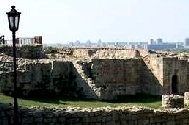 Excavated
ruins of the Castle (15-17th centuries) Excavated
ruins of the Castle (15-17th centuries)
The conserved ruins belonged to the
entrance complex of the medieval castle. They were excavated during
systematic archaeological diggings in the 1970's. However, only part of
the visible ruins originates from the Despotís period. The rest of
remains dates back to the period of Ottoman rule. The castle was greatly
destroyed in the late 17th century during Austrian-Turkish war clashes. |
|
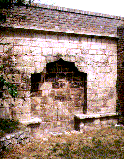 Turkish
drinking fountain (16th century) Turkish
drinking fountain (16th century)
Across from the ruins there is a 16th
century fountain built by Grand Vizier of Serbian origin, Mehmed
Pasha Sokolovic. As a boy of the subdued Christian people, he was taken
by Turks from his family as tribute, so-called 'blood tribute', and
raised in the strict Islamic spirit. As one of the best of
janissaries he stayed in royal service and took very high positions,
playing an important role in the history of the Ottoman Empire. This is
one of his remaining endowments. |
|
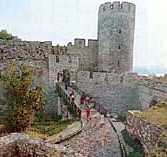 Medieval
structures (1404-1427) Medieval
structures (1404-1427)
Best preserved medieval remains are
located in the eastern section of the Acropolis, where the Despotís
gate still stands and serves as a passage. It was once protected by
a semicircular tower (partly reconstructed before WWII). On the inner
faÁade above the entrance one can see a small arched section probably
used to display a fresco painting of the Virgin Mary. |
|
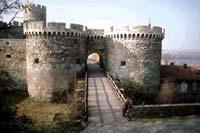 Barbican
of the Prison's Gate Barbican
of the Prison's Gate
After the first vain Turkish siege
of 1440, the Hungarians built a barbican in front of the Despotís
gate in order to better protect the main approach to the town from that
direction. The barbican is known today under its later Turkish name "Zindan
Gate" (zindan=prison) for, the Turks were used its two strong
semicircular towers as disreputable prisons. |
|
|
 Traces
of Roman ramparts Traces
of Roman ramparts
A segment of the Roman stone
wall and some minor traces of a Roman tower. The Romans
settled here in the 1st century AD, when they founded a legionary camp -
castrum known under the name Singidunum. Its first
defenses were made of earth and palisade, but by the end of the 2nd
century a fortified stronghold with stone ramparts made its appearance
at the same place. |
Lower Town
|
 Ruzica
Church in the Eastern Ward Ruzica
Church in the Eastern Ward
This is the oldest Belgradeís church in
terms of continuous occupation of the site. It was founded in the 15th
century and in the meantime suffered so much, that today is no longer
possible to see its original stones. The church is dedicated to the
Nativity of the Theotokos. During Turkish rule the church was converted
into a gunpowder store. In its interior there is a valuable iconostasis,
and the walls are covered with oil paintings made by a Russian artist.
After WWI it served as the military church of the fortress. |
|
 St.
Petka Chapel St.
Petka Chapel
The people honor St Petka, maybe because
she was the first Serbian woman to be blessed with the sainthood. She
lived at the beginning of the 11th century. The chapel was built in 1937
at the place of an original church which was built in the late 15th
century. There is a well (spring) in the church. Its water has some
mineral qualities, and people believe it is miraculous. |
|
 Remains
of the East gate (15th century) Remains
of the East gate (15th century)
Eastern gate I (the inner one) was
built at the beginning of the 15th century, along with its protecting
tower. Being situated in the northeastern rampart, it served as the main
entrance to the Lower town. Later on, between 1450 and 1456, Hungarians
added the Eastern gate II (the outer one, shown on the photo),
made in a form of barbican having two towers. This part of the fortress
was almost completely destroyed in WWI. |
|
 Nebojsa
tower (15th century) Nebojsa
tower (15th century)
Near the bank of the Danube stands one of
the most recognizable medieval towers of Belgrade. The Nebojsa tower
was built by Hungarians in the second half of the 15th century as a
cannon tower, in order to protect and defend the Lower town area. It was
located on the very edge of the medieval pier of Belgrade, thus
facilitating monitoring of all traffic across the Danube in Belgrade
area. |
|
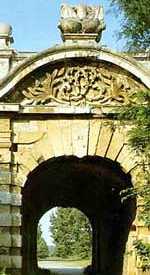 Gate
of Carl VI (inner facade), 18th century Gate
of Carl VI (inner facade), 18th century
The Austrians built the Gate of Czar
Karl VI (1736) in commemoration of their victories; they regarded it
as their triumphal arch. Today, this is undoubtedly the most important
Baroque monument preserved to the south of the rivers Sava and Danube.
When the gate was completed, it took on the role of the main entrance to
the Lower town from the two mediaeval eastern gates. |
For less
known terms of military architecture consult this fine
Glossary.
Description of the monuments: B. Rabotic
Please, rate this site!

Home/History
| Exhibition
| Photo Tour | Plan

|

 Big
Ravelin & Stambol Gate I (1740-1760)
Big
Ravelin & Stambol Gate I (1740-1760) Fortification
front & Stambol Gate II (1740-1760)
Fortification
front & Stambol Gate II (1740-1760) Southeast
rampart of the Acropolis (15th - 17th centuries)
Southeast
rampart of the Acropolis (15th - 17th centuries) Clock
Gate & Clock Tower (17-18th centuries)
Clock
Gate & Clock Tower (17-18th centuries) Fortress
cannon
Fortress
cannon  Turkish
Mausoleum (18th century)
Turkish
Mausoleum (18th century) Model
of the Castle
Model
of the Castle Excavated
ruins of the Castle (15-17th centuries)
Excavated
ruins of the Castle (15-17th centuries) Turkish
drinking fountain (16th century)
Turkish
drinking fountain (16th century) Medieval
structures (1404-1427)
Medieval
structures (1404-1427) Barbican
of the Prison's Gate
Barbican
of the Prison's Gate Traces
of Roman ramparts
Traces
of Roman ramparts  Ruzica
Church in the Eastern Ward
Ruzica
Church in the Eastern Ward St.
Petka Chapel
St.
Petka Chapel  Remains
of the East gate (15th century)
Remains
of the East gate (15th century) Nebojsa
tower (15th century)
Nebojsa
tower (15th century) Gate
of Carl VI (inner facade), 18th century
Gate
of Carl VI (inner facade), 18th century